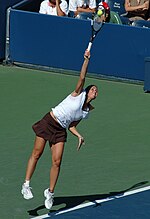Serve (tennis)
- Different tennis players serving
Flavia Pennetta (2005)
Andre Agassi (2005)
Andy Roddick (2007)
Roger Federer (2008)
J. McEnroe with foot fault (2007)
Novak Đoković (2009)
In tennis, the serve is the stroke with which a rally is opened.
regulate
The ball must be played in the diagonally opposite two-part T-field. Both feet of the server must be behind the line without touching the line at the moment the ball is hit, unless they are in the air after a jump. Only after hitting the ball is the player allowed to touch or cross the baseline or the imaginary extension of the center line or the sideline, otherwise he commits a foot error (exception: in the air, with a "jumped" service the Baseline are exceeded). A foot fault on the second serve is counted as a double fault and the point goes to the opponent.
The receiver, on the other hand, may be anywhere inside or outside the field of play. The feet do not have to be on the ground when the ball touches. The serve must take place from a rest position, the server may, for example, not make a run-up. A service is deemed to have taken place from the point at which the racket touches the ball.
If the player does not succeed in completing a service the first time, he has a second attempt. A special case arises if the ball touches the edge of the net during an otherwise rule-compliant service and then falls into the service area: This is assessed as a fault, but the player receives another attempt to serve. The chair referee signals this error with the exclamation "Let". On modern tennis courts, the referee is informed of the touch by an acoustic signal. In the search for measures to shorten the game, the abolition of the let rule was discussed from the 2010s onwards; this has already been abolished in alternative counting methods such as Fast4 Tennis . After a game, the right to serve changes.
Service technique
The leg position is usually oblique or slightly to the side of the baseline. The leg opposite the hitting hand points forward, in the case of right-handed people consequently the left leg. Various techniques are used for the actual stroke movement. As a rule, the ball is brought up in a quiet movement with an outstretched arm and thrown only slightly higher than the point of impact. At the same time, the batting arm descends in a counter-rotating movement, so that the club and the beating arm ideally form a straight line at the lowest point, with the club head almost pointing towards the ground. This extreme return of the arm with subsequent acceleration of the racket and hit at the highest point of the thrown ball is used to generate a dynamic movement in which all muscle chains work together, starting with the stretching of the legs through the rotation of the upper body to the tilting of the wrist. In this case, part of the acceleration is ultimately also achieved via the so-called whip effect. As a rule, the players jump into the field, on the one hand to achieve a more favorable stroke angle, on the other hand to bring additional pressure and spin on the ball through the swing.
The serve is considered the most difficult stroke for beginners.
tactics
The serve is the only blow that cannot be influenced by the opponent. A hard and well-placed serve is a valuable means of putting the opponent under pressure to determine the rally from the beginning and is therefore of the highest tactical importance. In general, the first serve is played with high risk, the second serve with more certainty.
In principle, all forms of twist that are common in tennis can also be used for serve: flat hit (cannon serve), topspin (twist) and slice . Both the topspin serve and the slice serve often have a characteristic sideways twist. From the point of view of the right-handed server, the twist jumps to the right, the slice to the left.
Often the first serve is the flat hit with only a slight forward spin, as the ball can reach the highest possible speed and is the most difficult to return. It is usually played with the intention of winning points ( ace ), but is risky due to its straight trajectory.
The topspin serve is particularly suitable for a second serve, as this occurs with greater certainty within the service area due to the Magnus effect . In addition, the return of this high and fast bouncing serve poses a certain challenge.
Trivia
The best male service players of the past few decades include Pete Sampras , Boris Becker , Goran Ivanišević , Ivan Lendl , Andy Roddick , Ivo Karlović and John Isner . A peculiarity was observed with the American John McEnroe , who hit with a foot position parallel to the net.
It is Samuel Groth who holds the record for the fastest serve ever in an official tournament game: 263 km / h, beaten on May 9, 2012 at the ATP Challenger tournament in Busan, South Korea. Since July 30, 2014, Sabine Lisicki has been the women's world record holder, who served at WTA Stanford in the first round match against Ana Ivanović at 210.8 km / h.
Web links
- Tennis tips : Explanations of serving technique and tactics
Individual evidence
- ↑ Tennis star Lisicki breaks serve world record. In: Spiegel.de. SPIEGEL, July 30, 2014, accessed May 1, 2020 .






